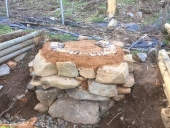posted 10 years ago
Thanks for the reply, Bryant. They had an old barrel and what seems to be a couple random spots where there's all kinds of left off trash. Melted plastic, metal remnants, cans, etc. To be clear, I actually burned that wood in the pit. It then hit me I should probably check into it. It was a set of about 3 steps from a porch and 2 2x8s about 8 feet long. I panicked when I found the following:
Incineration of CCA wood does not destroy arsenic. It is incredible, but a single 12 foot 2 x 6 contains about 27 grams of Arsenic - enough arsenic to kill 250 adults. Burning CCA wood releases the chemical bond holding Arsenic in the wood, and just one Tablespoon of ash from a CCA wood fire contains a lethal dose of Arsenic. Worse yet, Arsenic gives no warning: it does not have a specific taste or odor to warn you of its presence. No one disputes that the ash from burning CCA wood is highly toxic: It is illegal to burn CCA wood in all 50 states. This has serious implications for firefighters, cleanup and landfill operations.
Even more astonishing, minute amounts of 'fly ash' from burning CCA pressure treated wood, can have serious health consequences. The Journal of the American Medical Association reported on a family that burned CCA in a wood stove for winter heating. Their hair fell out, all family members suffered severe, recurring nosebleeds, extreme fatigue and debilitating headaches. The parents complained about 'blacking out' for periods of several hours, followed by long periods of extreme disorientation. Both children suffered frequent seizures described as 'grand mal'. The symptoms were finally traced to breathing minute amounts of arsenic laden dust leaking from the furnace as fly ash. The family's houseplants and fish died, too, victims of copper poisoning from the same dust.








